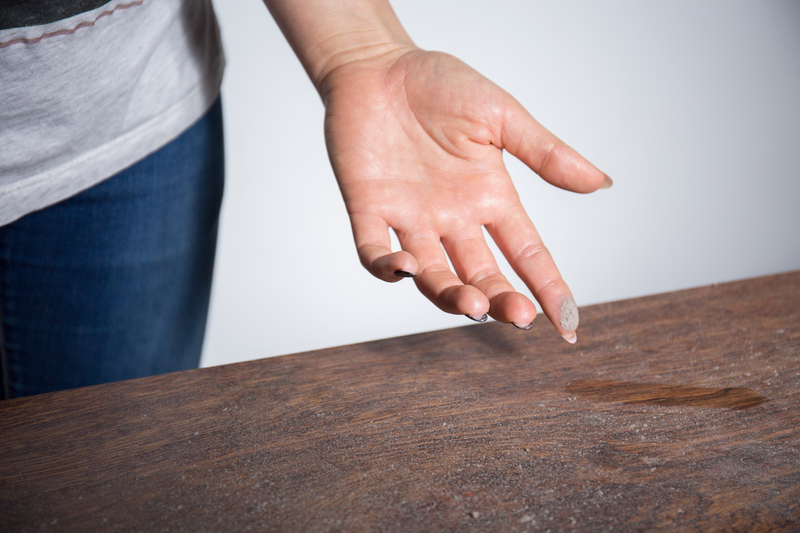Ditch the Scrubbing: How to Wash Away Burnt Residue from Stovetops
Posted on 20/09/2025
Ditch the Scrubbing: How to Wash Away Burnt Residue from Stovetops
Have you ever faced the frustrating challenge of burnt-on messes stuck to your stovetop after cooking? Instead of resorting to endless scrubbing that leaves your arms sore and your stovetop scratched, learn effective, stress-free solutions to safely and efficiently remove burnt residue from your stovetop. In this comprehensive guide, discover expert-approved tips to make your appliance sparkle -- without exhaustive scrubbing!

Why Burnt Residue Happens on Your Stovetop
Before diving into methods for cleaning burnt stovetops, it helps to understand what causes burnt-on buildup.
- Spillovers during cooking: Sauces, oil, or food can bubble over and quickly burn onto hot surfaces.
- High heat: Prolonged or high-heat use can bake residues onto the surface.
- Neglect: The longer burned-on residue sits, the harder it is to remove.
The key to maintaining a sparkling clean stovetop is routine cleaning, but if things have already gotten tough, don't worry -- we'll show you how to remove stubborn, burnt-on gunk with minimal effort.
Choosing the Right Cleaning Method for Your Stovetop
Stovetops come in different materials, and each requires a tailored approach to avoid scratches or discoloration:
- Glass and Ceramic Stovetops
- Stainless Steel Stovetops
- Gas and Electric Coil Stovetops
Let's explore how to wash away burnt residue from any stovetop with ease.
How to Clean Burnt Residue from Glass or Ceramic Stovetops
What You'll Need
- White vinegar
- Baking soda
- Microfiber cloths
- Plastic scraper or razor blade (for glass only)
- Spray bottle
- Non-abrasive sponge
Step-by-Step: A Scrub-Free Approach
- Let the stovetop cool completely. Cleaning a hot surface is dangerous and may worsen residue adherence.
- Spray with vinegar. Fill a spray bottle with white vinegar and spritz generously over the burnt areas. Vinegar cuts through grease and loosens grime.
- Apply baking soda. Sprinkle a thick layer of baking soda over the vinegar-soaked spots. This combination foams up, helping to break down burnt residues chemically.
- Let it sit. Wait for at least 20-30 minutes. For severe burns, let it soak for an hour.
- Wipe clean. With a damp microfiber cloth, gently wipe the area. Most residue will have loosened and can be lifted away effortlessly.
- Remove tough spots. For any lingering scorched patches, use a plastic scraper or a razor blade held at a 45-degree angle. Glide carefully -- never use steel wool or abrasive pads, which can scratch the surface.
- Finish and polish. Spritz once more with vinegar and buff dry using a clean cloth for a streak-free shine.
Bonus Tips
- Stubborn spots may require repeat treatment.
- Always check your manufacturer's guidelines before using a razor blade.
- Do not use heavy-duty or abrasive chemicals not rated for glass tovetops.
Cleaning Guide for Stainless Steel Stovetops
What You'll Need
- Warm water
- Baking soda paste (baking soda + water)
- Soft cloths
- Mild dish soap
- Olive oil or stainless steel polish (optional)
Step-by-Step Instructions
- Wipe loose debris. Brush away crumbs and loose particles first.
- Make a baking soda paste. Mix three parts baking soda to one part water to create a spreadable paste.
- Apply the paste to stains. Generously coat burnt stains and let sit for at least 30 minutes. Patience is key!
- Wipe away residue. Use a damp cloth to gently wipe away the paste. Most burnt-on food should lift easily without hard scrubbing.
- Use dish soap for greasy residues. Mix a few drops of mild dish soap with warm water and clean remaining messes with a sponge.
- Buff for shine. Once clean, polish your stovetop with a few drops of olive oil or a designated stainless steel polish, wiping in the direction of the grain.
Preventing Scratches
- Never use steel wool or abrasive powders.
- Always test cleaning products in a discreet corner first.
Getting Burnt Residue off Gas and Electric Coil Stovetops
Tools and Supplies
- Dish soap
- Baking soda
- Soaking basin or sink
- Old toothbrush
- Soft cloths
Instructions
- Remove grates and coils. Unplug coils (if applicable) and take off any removable grates or burner caps.
- Soak grates and coils. Place them in hot, soapy water for at least 20 minutes. Add a sprinkle of baking soda for tougher stains.
- Clean stovetop surface. While those soak, use a paste of baking soda and water to coat any burnt-on areas.
- Let soak, then wipe clean. After 20-30 minutes, use a damp cloth or soft sponge to wipe away loosened residue.
- Brush tough spots. If gunk remains on grates or coils, scrub gently with an old toothbrush or non-abrasive pad.
- Dry and replace. Allow all parts to dry fully before reassembling.
For extremely stubborn deposits on burner caps or grates, try soaking them overnight in a mixture of vinegar and water.
Natural Alternatives to Remove Burnt Stovetop Residue
Looking for green solutions? Eco-friendly ways to clean stove top burnt-on residue are effective and safe:
- Lemon Juice: Acidic lemon juice can dissolve burnt on stains when used with baking soda.
- White Vinegar: Not just for glass surfaces. Vinegar is safe for most stovetop types and is a degreaser.
- Salt Scrub: Combine salt and a little water for a gentle abrasive paste that helps lift grime (ideal for cast iron).
How to Use Vinegar and Baking Soda Together
- Spray vinegar on the burned residue areas.
- Sprinkle baking soda over the top -- watch it fizz!
- Leave for 20-30 minutes, then wipe away with a soft, damp cloth.
Helpful Commercial Products for Stovetop Burnt Residue
If natural solutions aren't cutting it, many effective, non-scrubbing cleaners exist. Look for:
- Stovetop cleaner creams (like Cerama Bryte, Bar Keepers Friend, Weiman)
- Non-abrasive scrub sponges designed for cooktops
- Specialized glass cooktop scrapers
Always follow manufacturer guidelines for your specific stove brand and model to avoid voiding warranties or damaging surfaces.
The Golden Rule: Avoid Abrasives at All Costs
Resist the urge to reach for harsh scrubbing pads, steel wool, or gritty powders. These can leave permanent scratches, clouding, or discoloration.
What Not to Use on Stovetops
- Scouring powder or steel wool
- Metal spatulas
- Oven cleaner (unless manufacturer approved)
- Ammonia on stainless steel or glass
Stick with gentle, non-abrasive options for the best results.
Preventing Burnt Residue on Your Stovetop
Once you've gone through the trouble of removing burnt residue from your stovetop, keep it clean and gleaming with these simple habits:
- Wipe up spills immediately -- nothing bakes on if it's quickly wiped away.
- Deep clean weekly to prevent buildup.
- Use splatter guards or pot lids when boiling or frying.
- Avoid cooking on too high heat unless necessary.
Not only does this save you from scrubbing in the future, but it also ensures your kitchen always looks inviting and well-kept.
FAQs: Removing Burnt Residue from Your Stovetop
- How do you get burnt food off a glass stove without scratching it?
Use the vinegar and baking soda soak method outlined above and a plastic scraper if needed. Avoid rough scrubbing pads. - Can baking soda damage my stovetop?
When used with plenty of water and a soft cloth, baking soda is safe and non-abrasive for most surfaces. - How long should I leave cleaning mixtures on burnt residue?
Let it sit for 20-30 minutes, or longer for severe buildup -- patience allows the cleaner to work! - What's the fastest way to clean a burnt stovetop?
For speed, try commercial cleaner sprays designed for your stovetop type and rinse well.

Conclusion: Enjoy a Clean Stovetop with Minimal Effort
It's entirely possible to ditch the scrubbing and quickly wash away burnt-on stovetop stains if you know the right techniques. Whether you have glass, ceramic, stainless steel, or gas stovetops, gentle but effective solutions like baking soda, vinegar, and simple paste soaks will do the heavy lifting, sparing you time and elbow grease.
Regular upkeep and spill management can help you avoid burnt residue altogether, keeping your kitchen looking spotless and saving time in the long run. Choose the right method, use the right supplies, and your stovetop will reward you with years of gleaming performance -- no scrubbing marathon required.
Ready to Enjoy a Gleaming, Scrub-Free Stovetop?
Follow these expert-approved steps to keep your stove looking its best, and spend more time enjoying your meals and less time battling tough stains!




